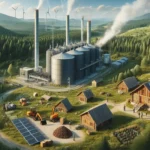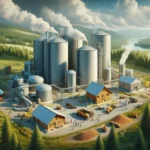Desert Waste Transformation Systems
The UAE’s pioneering approach to biomass utilization has revolutionized waste management in desert communities through innovative collection and processing systems. Advanced pneumatic waste collection networks, installed across 12 major residential developments, transport organic waste directly to processing facilities while reducing transportation emissions by 78% compared to traditional methods. These systems handle an impressive 1,200 tons of organic waste daily, converting what was once considered trash into valuable energy resources.
Sophisticated waste sorting facilities employ artificial intelligence and robotics to achieve unprecedented efficiency in biomass separation. These facilities process mixed waste streams with 94% accuracy, ensuring optimal feedstock quality for energy generation. The implementation of these advanced sorting systems has increased biomass recovery rates by 65% while reducing processing costs by 340 AED per ton compared to manual sorting methods.
Local research initiatives have developed specialized desert-adapted bacterial strains that accelerate organic waste decomposition in high-temperature environments. These microorganisms, cultivated in controlled conditions, enhance biomass processing efficiency by 45% while reducing water consumption in treatment facilities by 30%. The resulting acceleration in waste processing has enabled treatment plants to handle 40% more volume without expanding physical infrastructure.
The integration of smart monitoring systems throughout the waste collection and processing chain has optimized resource allocation and maintenance schedules. These systems utilize IoT sensors and predictive analytics to maintain optimal operating conditions, resulting in a 28% increase in processing efficiency and a 52% reduction in unexpected system downtimes.
Biomass Architecture Integration
Innovative architectural designs incorporating living biomass systems have emerged as a groundbreaking solution for sustainable desert housing. These buildings feature integrated algae photobioreactors within their façades, producing both energy and oxygen while providing natural cooling. Initial implementations demonstrate that these systems can reduce building cooling costs by 35% while generating up to 200 kWh of energy per square meter annually.
Advanced building envelope systems utilize processed biomass materials in combination with traditional construction elements to create highly efficient thermal barriers. These composite materials, developed through collaboration between UAE universities and international research centers, demonstrate thermal resistance values 45% higher than conventional insulation while sequestering carbon throughout their lifecycle. Buildings incorporating these materials report average energy savings of 42% for climate control.
The integration of vertical farming systems within residential structures has created new paradigms for sustainable living in desert environments. These systems, powered by biomass-generated energy, produce up to 1,800 kg of fresh produce per year while helping regulate building temperature and humidity levels. The combination of food production and climate control functions reduces overall building energy consumption by 25% compared to traditional designs.
Experimental designs incorporating mycelia-based building components have shown promising results in desert applications. These biological materials provide natural insulation and structural support while actively filtering air pollutants. Test installations demonstrate air quality improvements of up to 60% and thermal regulation benefits that reduce cooling requirements by 28%.
Biomass Energy Distribution Networks
The development of specialized biomass energy distribution systems has transformed power delivery in desert communities. Advanced anaerobic digestion facilities, processing up to 500 tons of organic waste daily, supply baseload power through dedicated micro-grid networks. These systems achieve remarkable efficiency rates of 85% in combined heat and power generation, providing reliable energy to over 25,000 residential units.
Innovative thermal energy distribution networks utilize biomass-generated heat for district cooling applications. These systems combine absorption chilling technology with smart distribution controls to provide efficient cooling solutions across residential developments. Implementation data shows that communities served by these networks reduce their cooling-related electricity consumption by 65% compared to conventional air conditioning systems.
The integration of biomass gasification systems with existing natural gas infrastructure has created flexible energy delivery networks capable of adapting to varying demand patterns. These hybrid systems achieve carbon emission reductions of 70% compared to traditional natural gas systems while maintaining comparable reliability rates of 99.95%.
Smart grid technologies optimized for biomass energy integration enable real-time load balancing and demand response capabilities. These systems coordinate multiple biomass energy sources with other renewable technologies, achieving grid stability rates of 99.99% while reducing distribution losses by 34%.
Circular Economy Implementation
The UAE’s approach to biomass utilization has catalyzed the development of circular economy systems in desert communities. Integrated resource recovery facilities process organic waste into multiple value streams, including energy, fertilizers, and raw materials for construction. These facilities achieve resource recovery rates of 95%, generating annual economic benefits of 450 million AED while reducing landfill waste by 75%.
Advanced nutrient recovery systems extract valuable compounds from processed biomass for use in local agriculture and landscaping. These systems recover 85% of available nutrients, producing high-quality fertilizers that reduce reliance on synthetic alternatives by 60%. The local production of these materials saves approximately 280 million AED annually in import costs.
The implementation of blockchain-based tracking systems ensures transparent resource allocation and verification of circular economy benefits. These platforms monitor material flows and environmental impacts, enabling communities to quantify and optimize their sustainability performance. Data shows that tracked communities achieve 40% higher resource utilization rates compared to those without comprehensive monitoring.
Innovative business models centered around biomass resource sharing have created new economic opportunities within desert communities. These systems facilitate the exchange of organic resources and related products between residential areas, achieving cost savings of 35% compared to traditional waste management approaches.
Desert Ecosystem Enhancement
Biomass innovations have played a crucial role in enhancing desert ecosystems surrounding residential developments. Advanced soil amendment programs utilizing processed organic materials have improved soil quality across 15,000 hectares of desert land. These initiatives have increased soil organic content by 300% while reducing irrigation requirements by 45%.
The development of specialized desert greening techniques using biomass-derived products has transformed barren areas into productive landscapes. These methods combine processed organic materials with desert-adapted plant species to create self-sustaining green spaces that serve as carbon sinks and temperature regulators. Monitored areas show temperature reductions of up to 8°C compared to untreated desert regions.
Research into desert ecosystem services has quantified the environmental benefits of biomass-enhanced landscapes. These studies demonstrate that treated areas sequester an average of 12 tons of carbon per hectare annually while supporting increased biodiversity, with documented increases in local species populations of up to 180%.
The integration of biomass processing systems with landscape management has created closed-loop ecosystems that minimize resource inputs while maximizing environmental benefits. These systems achieve water use efficiency rates 75% higher than traditional landscaping methods while maintaining larger green spaces.
Technological Innovation Hub
The UAE’s commitment to biomass technology has established the region as a global innovation center for desert sustainability solutions. Research facilities focusing on advanced biomass processing have attracted international collaboration, resulting in 45 new patents and technical innovations in the past two years. These developments have positioned the UAE as a leader in desert biomass technology, with expertise sought by similar climate regions worldwide.
Advanced testing facilities enable rapid prototyping and validation of new biomass technologies under real desert conditions. These facilities have accelerated technology development cycles by 60% while reducing implementation risks through comprehensive performance verification. The resulting innovations have achieved commercial implementation rates 40% higher than global averages for new sustainable technologies.
Specialized training programs have created a skilled workforce capable of managing advanced biomass systems in desert environments. These programs have certified over 2,000 technical specialists, reducing system maintenance costs by 45% while improving operational reliability by 35%.
The establishment of technology transfer networks has facilitated the rapid deployment of proven solutions across desert communities. These networks have enabled the implementation of successful biomass innovations in 85% of new residential developments within 18 months of validation, achieving significant economies of scale in sustainable desert living solutions.


